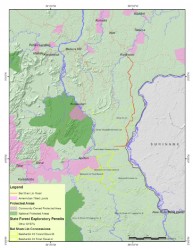Chinese logging company Baishanlin has constructed a 130km-long road extending almost to Region Nine without awaiting an impact study and authorities have told alarmed stakeholders that construction will stop for now.
“Where the road stops right now as the main road, there will be no more road from now,” Deputy-Commissioner of Forests Tashreef Khan told villagers and others from the North Rupununi, who gathered for a scoping meeting at Apoteri, Region Nine on Tuesday.
Stabroek News was present at the meeting, where Khemraj Parsram, the Director for the Compliance and Enforcement division of the Environmental Protection Agency (EPA) said that the road would be covered under the Environmental and Social Impact Assessment (ESIA) currently being done. However, some at the meeting said this was “backwards” since a large portion of the road has already been constructed.
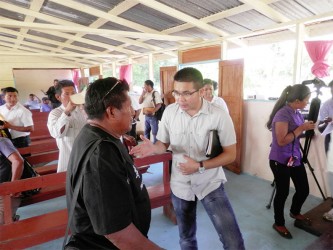
Guyana Forestry Com-mission (GFC) maps seen by Stabroek News do not show a road or trail where the Baishanlin road is now located. Some maps indicate a planned road alignment but it appears to differ somewhat from the actual road constructed by the Chinese company.
Baishanlin has applied to the EPA for permission to begin large-scale logging and sawmilling operations at its forest concessions in Regions Six and Nine and the meeting in the remote rainforest community on the western bank of the Essequibo was a requirement for the ESIA for the controversial Chinese company’s proposed logging project. The company’s two sites in Region Nine covers 102,332 acres and 156,557 acres, respectively. Area A is located on the Left Bank Essequibo River, Right Bank Rewa River, and Right Bank Aktayaru Creek, while Area B is located on the Left Bank Berbice River and Right Bank Essequibo River.
Baishanlin has announced big plans in various sectors for Guyana but concerns have been raised by some analysts that its primary interest is logs for export with little downstream processing. Baishanlin’s access to key parts of the economy have also raised questions about the regulation of its business by the forestry commission and associated bodies.
Those in attendance at the Apoteri meeting raised a number of issues, including the building of the road, which is being constructed at a fast pace with a bridge reportedly expected to be constructed across the Berbice river. Other issues included a potential conflict-of-interest between a top EPA official and the consultant hired to do the ESIA, who is her husband. The possible impacts of the project on the rainforest upon which the nearby indigenous communities depend and on which their fledging eco-tourism project is based, were also raised.
When the subject of the road was first raised, Khan acknowledged that there was road development. “There is upgrading of roads. There is upgrading of trails, so that the company could access the area,” he said. “They open up old roads and trails.”
Subsequently, as speaker after speaker raised concerns about the road, Khan had to address the issue.
‘Clear and present danger’
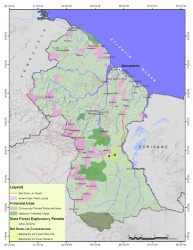
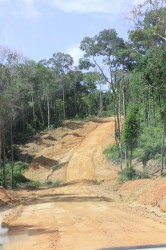
“Miners already on the road. Hunters already on the road. It is going to affect the waterways,” Sydney Allicock, of Surama and the North Rupununi District Development Board (NRDDB), said. He pointed to other operations involving Baishanlin and expressed concern that the same could happen in Region Nine. Further, he said, the process was “backwards” as the company is only now holding a scoping meeting while there are already people traversing the forest.
Citing the construction of the road, Vanda Radzik, adviser to the North Rupununi’s Community Monitoring, Reporting and Verification project, said that the process was “back-to-front” even as she noted that no ESIA was done for the project. She said that it begs more questions than answers and people would lose trust and confidence in the process. “It’s just not enough,” she said.
Radzik revealed that according to a report from someone who had traversed the road recently, it was being built at a very fast rate and was described as being in a better condition than the Linden-Lethem road. She said that logs were seen being carried out and there were many Chinese workers but few Guyanese and they were not involved in the construction. “There was an abundance of Chinese observed with just a few local Guyanese cooks and chainsaw operators,” she reported.
There was also lots of hunting being done, Radzik said. “Hunting appears to be unregulated and uncontrolled, lots of reports of people shooting numerous tapir and labba in an apparently unregulated, uncontrolled and unmonitored way,” she reported. She said that according to the report given, one Saturday, at about 6.30 pm in the evening, a well-kitted out truck with flood-lights and shooting bench mounted high behind the cab was observed moving up and down the road. “Most detrimental impacts and effects is from the opening of this trail/road and its apparently uncontrolled access and the consequences on biodiversity and resources on lands used by Amerindians,” she added.
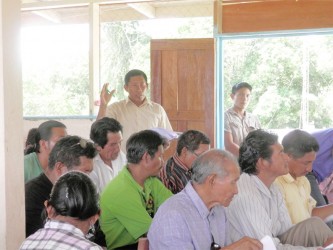
Radzik said that there was apparently no control on access and also pointed out that one mining operation was identified. A “mining road” was being pushed directly west to the Berbice River, where there was an intention to build a bridge there, she added. Radzik said that according to the report received, this mining road extends for about 16.5 km and has reached the Berbice River about 20 km east of Apoteri. She said that the person who had made the report spoke to the crew there who informed that they are to put a bridge across the Berbice River at a point between 40 to 50 metres wide and they then plan to continue on to the Essequibo in the area of Apoteri where they reportedly have a mining concession. According to the report, the mining crew plans to be in the area by year-end, she said.
Radzik questioned how the road was being constructed without an ESIA being done and also said that it was a “clear and present danger” that would affect Apoteri directly. If the activities continue, it will rubbish all their efforts in the ESIA process, she said.
She recommended a cease-order on the road up to where it is now. Several other persons raised the issue of the road and Rene Edwards of Conservation International also called for a halt to construction of the road.
Monitoring has to be strengthened
Khan said that the GFC recognised the concerns raised and acknowledged that monitoring has to be strengthened. He said that the company was given approval to operate to recover limited costs and had permission to harvest 4,000 hectares, of which only 3,500 hectares were harvested. Baishanlin was also given permission to “upgrade the trails,” he said.
In its project summary, Baishanlin had said that in the preparatory phase, activities would include establishing initially more than 196 km of all-weather roads to allow access to the concession area. According to the company, the all-weather roads will incorporate a number of bridges and culverts and the establishment of a number of borrow pits. The construction of the roads will lead to the felling of trees along the planned road alignment, it had said.
According to Khan, the Chinese company was advised to follow old trails and he said that where the main road stops at the moment, there will be no more road. “Don’t expect any more road or any more bridge,” Khan said.
Khan added that Baishanlin will also not build a bridge across the Berbice River and would not proceed with the road any further until such time as further permission is given. Mining blocks have reportedly also been granted in that area and the section of the road leading from the Baishanlin road to the Berbice River is reportedly being done by a miner. Khan acknowledged that monitoring has to be done and said too that in relation to the reported mining operation, the Guyana Geology and Mines Commission (GGMC) will monitor and there is an ongoing investigation into that report. He said that in building the road, Baishanlin had to follow the GFC code of practice even as he noted that under forestry laws, the company can log to recoup a percentage of its cost.
Meanwhile, as the meeting started, questions were raised regarding a conflict of interest since the wife of the consultant, Isidro Espinosa of Environmental Engineering Solutions, is Geeta Singh, who is the head of the EPA’s permitting division. Normally, Singh oversees the ESIA process.
The officials hastily said that Singh was removed from all matters involving Baishanlin. Parsram said that he was in charge of overseeing the ESIA process for this project because Singh was removed after acknowledging a conflict of interest. “Geeta Singh has been removed from the process,” he said. “Ms Singh has been removed from any part of this project.” He further said that they recognised that the consultant is Singh’s husband and she signed the conflict of interest form.
Veetal Rajkumar, the Chairman of the Environmental Assessment Board (EAB) said that the company has been doing baseline studies in the area and stressed that it would be the EAB who would approve the ESIA and not the EPA.
Baishanlin’s representative at the meeting Lun Weikang, who is the assistant to the General Manager, said that they use Guyanese wood in their factories in China but now want to market their products using the ‘Made in Guyana’ label. He said that the company currently injects US$400,000 monthly in foreign exchange earnings from log exports and, according to his presentation, aims to process an average of 200,000 cubic metres of logs annually. Baishanlin, he said, wants to utilise the forest scientifically, under the laws of Guyana.
‘Our forest is our livelihood’
Michael Williams, the Chairman of the NRDDB, noting the use of the land for hunting and tourism, questioned whether the indigenous people would still have access to the land. One concession is about 300 metres away from Apoteri village, across the Essequibo River. He also pointed out that the communities of Apoteri, Rewa and Crashwater have applied for land extensions and some of their claims fall within the Chinese company’s concessions. He demanded that the applications be considered before Baishanlin is permitted to move ahead. He also questioned whether an ESIA was done for the road.
In response, Khan said that Baishanlin cannot stop any indigenous person from visiting the area to undertake their traditional activities. Parsram said that there was no assessment done for the road. “The road has to be considered under this assessment,” he said.
Rudolph Edwards, the manager of the community-owned Rewa Eco-lodge expressed concern about the impact of logging. Before being cut short by Parsram, he explained that their fledging ecotourism product depends on the pristine state of the area. Mike Allicock of the NRDDB also stressed the tourism angle and said it called for long-term thinking. Campbell James, the toshao of Apoteri also pointed out that the community has applied for land extension and said that the process must be respected. He said that the logging will have negative impacts on the forest and wildlife and pointed out that the concession is just 300 metres away from Apoteri. Among other concerns, Nicholas Fredericks spoke on the road and questioned why mining and logging concessions were being given out when the communities are doing so much for conservation. A lot more consultations are needed, he said.
“We are the closest to the concession,” Zachary Xavier, an Apoteri resident said. “Our forest is our livelihood. We get everything from it…what will happen if we say yes to Baishanlin,” he questioned. He said that the road will affect the community even as he noted that Amerindians are “friendly to the forest.” He further pointed out that the people cannot move anywhere now because the communities are surrounded by the concessions. He said that for so long, Amerindian communities have had to beg for land but it is allocated fast to foreign companies. “We are too close to the concession. We don’t know what is going to happen,” he said.
Gloria Duarte, a councillor of Rupertee, said that they feel there is no system to protect the indigenous people. She said that the land extension applications must be dealt with first.
CI’s Rene Edwards also said that the proposed timeframe for the ESIA, between three to five months, was too short. There were also calls for more extensive consultations to be done in the communities.
A resident Dale Edwards echoed the concerns of residents and noted the concerns about the impacts on tourism. “They simply telling you they don’t want the company to enter the land that they are using,” he asserted.
